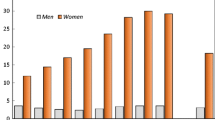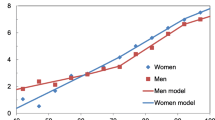Abstract
Purpose
Osteoporosis is one of the most common clinical problems among the elderly population. China is one of the countries most threatened by osteoporosis and fragility fracture, because of its large population and aging population trends during recent decades. We aimed to estimate the disease burden of fracture from 1990 to 2019 in China.
Methods
We performed a secondary analysis of fractures using detailed information for China from the Global Burden of Disease Study 2019. Fracture incidence and prevalence, rate of years lost to disability from fractures, and term secular trends in China from 1990 to 2019 were compared by sex, age, cause, and nature of fracture.
Results
The numbers for incidence and prevalence of fracture and years lived with disability (YLDs) from fractures in China increased from 12.54 million, 28.35 million, and 1.71 million in 1990 to 21.27 million, 67.85 million, and 3.79 million in 2019, respectively, increases of 70%, 139%, and 122%, respectively. In 2019, falls was the leading cause of fractures, with an age-standardized incidence rate (ASIR) of 762 per 100 000 (95% uncertainty interval [UI] 629–906), an age-standardized prevalence rate (ASPR) of 1863 per 100 000 (95% UI 1663–2094), and an age-standardized YLD rate (ASYR) of 103 per 100 000 (95% UI 69–147). Fall-associated deaths and disability-adjusted life-years (DALYs) from low bone mineral density increased greatly during the most recent three decades. Fracture of patella, tibia or fibula, and ankle were the most frequent fracture types, with an ASYR of 116 per 100 000 (95% UI 75–169). Hip fracture had more incident cases in adults ≥ 60 years old, and was more frequent for females.
Conclusions
The burden from fractures has increased significantly since 1990 in China. Falls and road injuries are the main causes of the increase. The fall-associated health burden from osteoporosis needs to be prioritized, with longer-term commitment to its reduction required.






Similar content being viewed by others
Data availability
The original contributions presented in the study are included in the article/Supplementary Material. Further inquiries can be directed to the corresponding authors.
References
Leslie WD, Morin SN (2014) Osteoporosis epidemiology 2013: implications for diagnosis, risk assessment, and treatment. Curr Opin Rheumatol 26(4):440–446
Organization WH (1994) Assessment of fracture risk and its application to screening for postmenopausal osteoporosis. Report of a WHO Study Group. World Health Organization technical report series 843:1–129
Bliuc D, Nguyen ND, Milch VE, Nguyen TV, Eisman JA, Center JR (2009) Mortality risk associated with low-trauma osteoporotic fracture and subsequent fracture in men and women. JAMA 301(5):513–521
Borgström F, Zethraeus N, Johnell O et al (2006) Costs and quality of life associated with osteoporosis-related fractures in Sweden. Osteoporos Int 17(5):637–650
Black DM, Rosen CJ (2016) Clinical Practice Postmenopausal Osteoporosis. New Engl J Med 374(3):254–262
Kanis JA, Johnell O, Oden A et al (2000) Long-term risk of osteoporotic fracture in Malmö. Osteoporos Int 11(8):669–674
Wang SY, Li YH, Chi GB et al (2008) Injury-related fatalities in China: an under-recognised public-health problem. Lancet 372(9651):1765–1773
Yang G, Wang Y, Zeng Y et al (2013) Rapid health transition in China, 1990–2010: findings from the Global Burden of Disease Study 2010. Lancet 381(9882):1987–2015
Chen P, Li Z, Hu Y (2016) Prevalence of osteoporosis in China: a meta-analysis and systematic review. BMC Public Health 16(1):1039
Cheng X, Zhao K, Zha X et al (2021) Opportunistic screening using low-dose ct and the prevalence of osteoporosis in china: a nationwide, multicenter study. J Bone Mineral Res 36(3):427–435
Chen W, Lv H, Liu S et al (2017) National incidence of traumatic fractures in China: a retrospective survey of 512 187 individuals. Lancet Glob Health 5(8):e807–e817
Chau PH, Wong M, Lee A, Ling M, Woo J (2013) Trends in hip fracture incidence and mortality in Chinese population from Hong Kong 2001–09. Age Ageing 42(2):229–233
Chen FP, Shyu YC, Fu TS et al (2017) Secular trends in incidence and recurrence rates of hip fracture: a nationwide population-based study. Osteoporos Int 28(3):811–818
Wu TY, Hu HY, Lin SY, Chie WC, Yang RS, Liaw CK (2017) Trends in hip fracture rates in Taiwan: a nationwide study from 1996 to 2010. Osteoporos Int 28(2):653–665
Xia WB, He SL, Xu L et al (2012) Rapidly increasing rates of hip fracture in Beijing, China. J Bone Mineral Res 27(1):125–129
Ling X, Cummings SR, Mingwei Q et al (2000) Vertebral fractures in Beijing, China: the Beijing Osteoporosis Project. J Bone Mineral Res 15(10):2019–2025
Tian FM, Sun XX, Liu JY, Liu ZK, Liang CY, Zhang L (2017) Unparallel gender-specific changes in the incidence of hip fractures in Tangshan. China Arch Osteoporos 12(1):18
Zhang C, Feng J, Wang S et al (2020) Incidence of and trends in hip fracture among adults in urban China: a nationwide retrospective cohort study. PLoS Med 17(8):e1003180
National Bureau of Statistics of China (2021) China Statistical Yearbook 2021. Bejing, China. http://www.stats.gov.cn/sj/ndsj/2021/indexeh.htm
Murray CJL, Lopez AD (2013) Measuring the global burden of disease. N Engl J Med 369(5):448–457
GBD (2019) Fracture Collaborators (2021) Global, regional, and national burden of bone fractures in 204 countries and territories, 1990–2019: a systematic analysis from the Global Burden of Disease Study 2019. Lancet Healthy Longev 2(9):e580–e592
GBD (2019) Diseases and Injuries Collaborators (2020) Global burden of 369 diseases and injuries in 204 countries and territories, 1990–2019: a systematic analysis for the global burden of disease study 2019. Lancet 396(10258):1204–1222
National Institute for Health and Care Excellence (2019) Surveillance of osteoporosis: assessing the risk of fragility fracture (NICE guideline CG146). National Institute for Health and Care Excellence (NICE), London. https://www.ncbi.nlm.nih.gov/books/NBK551799/
Veronese N, Maggi S (2018) Epidemiology and social costs of hip fracture. Injury 49(8):1458–1460
Chevalley T, Herrmann FR, Delmi M et al (2002) Evaluation of the age-adjusted incidence of hip fractures between urban and rural areas: the difference is not related to the prevalence of institutions for the elderly. Osteoporos Int 13(2):113–118
Black DM, Cummings SR, Karpf DB et al (1996) Randomised trial of effect of alendronate on risk of fracture in women with existing vertebral fractures. Fract Interv Trial Res Group Lancet 348(9041):1535–1541
Fink HA, Milavetz DL, Palermo L et al (2005) What proportion of incident radiographic vertebral deformities is clinically diagnosed and vice versa? J Bone Mineral Res 20(7):1216–1222
Curtis EM, van der Velde R, Moon RJ et al (2016) Epidemiology of fractures in the United Kingdom 1988–2012: variation with age, sex, geography, ethnicity and socioeconomic status. Bone 87:19–26
Tsuda T (2017) Epidemiology of fragility fractures and fall prevention in the elderly: a systematic review of the literature. Curr Orthop Pract 28(6):580–585
Gillespie LD, Robertson MC, Gillespie WJ et al (2012) Interventions for preventing falls in older people living in the community. Cochrane Database Syst Rev 9:Cd007146
Feskanich D, Willett W, Colditz G (2002) Walking and leisure-time activity and risk of hip fracture in postmenopausal women. JAMA 288(18):2300–2306
Bischoff-Ferrari HA, Willett WC, Wong JB, Giovannucci E, Dietrich T, Dawson-Hughes B (2005) Fracture prevention with vitamin D supplementation: a meta-analysis of randomized controlled trials. JAMA 293(18):2257–2264
Agarwal-Harding KJ, Meara JG, Greenberg SL, Hagander LE, Zurakowski D, Dyer GS (2015) Estimating the global incidence of femoral fracture from road traffic collisions: a literature review. J Bone Joint Surg 97(6):31
Johnell O, Kanis JA (2006) An estimate of the worldwide prevalence and disability associated with osteoporotic fractures. Osteoporos Int 17(12):1726–1733
Acknowledgements
The estimates used in this manuscript are based on the GBD data and methodologies. We appreciate the visionary global health leadership of the Institute for Health Metrics and Evaluation (IHME) in Seattle, Washington, and the contribution of all anonymous collaborators, without whom this report would not be possible.
Funding
This work was supported by grants from the National Natural Science Foundation of China [grant number 81870564 to P-FS].
Author information
Authors and Affiliations
Contributions
ZZ conceived the study, collected data, performed the statistical analysis, and participated in writing and preparation of the report. TZ and YS were involved in the data collection, interpretation of the data and preparation of the report. P-FS designed and coordinated the study, acquired funding, performed the statistical analysis, and participated in writing and editing the final report. P-FS assumes full responsibility for the overall content of this report. All authors contributed to the article and approved the submitted version.
Corresponding author
Ethics declarations
Conflicts of interest
None.
Additional information
Publisher's Note
Springer Nature remains neutral with regard to jurisdictional claims in published maps and institutional affiliations.
Supplementary Information
Below is the link to the electronic supplementary material.
Rights and permissions
Springer Nature or its licensor (e.g. a society or other partner) holds exclusive rights to this article under a publishing agreement with the author(s) or other rightsholder(s); author self-archiving of the accepted manuscript version of this article is solely governed by the terms of such publishing agreement and applicable law.
About this article
Cite this article
Zhu, Z., Zhang, T., Shen, Y. et al. The burden of fracture in China from 1990 to 2019. Arch Osteoporos 19, 1 (2024). https://doi.org/10.1007/s11657-023-01353-4
Received:
Accepted:
Published:
DOI: https://doi.org/10.1007/s11657-023-01353-4




